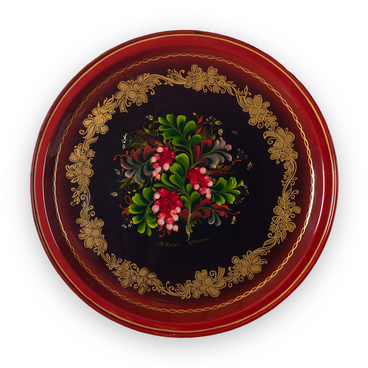Irina Grigoryevna Smykova was born in Nizhny Tagil in 1958. In 1980, she joined the tray painting workshop at the Emalposuda (Enamelware) factory which was actively reviving the traditional art of tray painting. After the factory was closed in the early 1990s, Irina Smykova worked at several other tray painting factories and later became a freelance artist.
In the 1980s, Irina Smykova worked under the guidance of the leading tray painting artist Tamara Vladimirovna Yudina and quickly mastered the single-layer flower painting technique. However, she did not stop there. She began to study the design of Nizhny Tagil storage chests and the traditions of lubok, a Russian popular print.
With the help of Vasily Alexeyevich Baradulin, an art historian from the Moscow Research Institute of Art Industry, Irina Smykova developed a unique direction in tray painting. She painted urban genre scenes with lubok elements.
The museum collection features the tray “Pastoral Scene” designed by the artist in 1993. She depicted a romantic scene with a young man and a young woman sitting in the meadow. The girl steals a look at her companion who is trying to impress her. He holds a balalaika. The artist followed all the traditional conventions of the pastoral genre. She filled the composition with a calm and serene atmosphere of a countryside landscape, distinguished by harmony between people and nature, and a muted color palette.
The genre scene was created using the quick single-layer painting technique with two-color brushstrokes. With the help of large strokes, the artist designed a landscape and achieved a three-dimensional effect when depicting the figures. However, their faces and hands were painted in a more primitive style using multiple layers of paint. They are not detailed and resemble the style of 18th-century lubok painting on storage chests.
Over the years, Irina Smykova has created a gallery of images that include merchants and their wives, wealthy peasants, urban commoners, and workers. Her genre scenes were inspired by proverbs, comic verses, and anecdotes. Her trays, such as “Tea Party”, “Matchmaking”, “Kuzma’s Mother”, and “Marusya’s Love” became popular. These are small stories from everyday life with its joys, struggles, love, and hate, with their own philosophy. The artist’s trays have been displayed at various exhibitions and have entered the collections of museums all across Russia.


